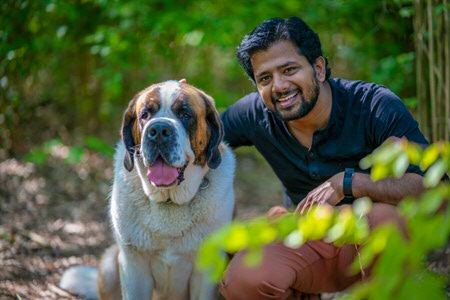'Nine-to-five jobs are underappreciated'
The experimental research conducted at the Faculty of Science and Engineering was brought to an abrupt halt when a pandemic entered our country without politely knocking on the door. However, no crisis is strong enough to stop scientists from doing science. How are they managing this? Aditya Iyer is the first in a series of young scientists who are sharing their stories with us.
Going from working in the lab for approximately 60 hours a week to working a nine-to-five job from home – it definitely takes some getting used to. Iyer, a 33-year-old post-doctoral researcher from the Membrane Enzymology research group, is not one to complain though. ‘I’ve been very lucky, actually. One week before the labs were closed down, we already expected strict measures. Therefore, I quickly finished my experiments for a paper that we had to submit. I had to convince my supervisor that I really had to go to the lab for one final day because we needed the data. Eventually, he agreed.’ So, when the lockdown was enforced, there was a lot of work that could be done from home.
Analysing the research data and writing a scientific paper are still the main items on Iyer’s to-do list. Working in the lab in shifts, which has been allowed recently, is not always possible for him: ‘My experiments run for longer than half a day.’ But if he were to be permitted to work night shifts, he would be able to continue his work as planned. He would need another person to work alongside him for safety reasons, though. Forever the optimist, Iyer smiles and says: ‘No one prefers to work during the night and sleep during the day, but desperate times call for desperate measures.’

Iyer is currently working on two different projects. The first aims to discover how bacterial cells cope with environmental stress, while the second project is more about how to visualize bacteria in general. To make bacteria visible under a microscope, the organisms are usually tagged with a fluorescent protein. These proteins are, however, not suited to long-term imaging since they bleach fairly quickly. Iyer and his colleagues therefore developed a protein tag that allows the use of organic dyes instead.
No matter how exciting these projects are, working on them solely on the computer can get a bit dull at times. Luckily, Iyer has found some little rays of sunlight to brighten his days. One of these is his very lazy, yet very sweet, Saint Bernard dog Arya. She gets to spend way more time with her favourite human now. Iyer has found another source of joy in working out with friends – online and therefore at a safe distance. ‘Before, there was always something more important to work on or an upcoming meeting to prepare for. As I now stop working at 5 p.m., I can really appreciate free time and focus more on my health. Did you know that the sun is beautiful around this time in the afternoon? I do now.’
Text: Kaila Ronde
| Last modified: | 09 June 2020 1.11 p.m. |
More news
-
10 June 2024
Swarming around a skyscraper
Every two weeks, UG Makers puts the spotlight on a researcher who has created something tangible, ranging from homemade measuring equipment for academic research to small or larger products that can change our daily lives. That is how UG...
-
21 May 2024
Results of 2024 University elections
The votes have been counted and the results of the University elections are in!

